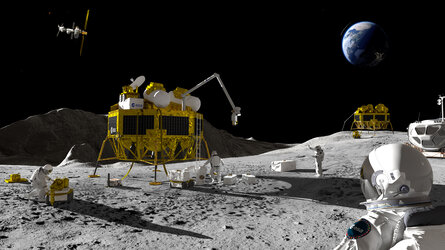Applications now open for the Space Debris Training Course
Space debris is a hazard to our satellites and spacecraft as well as a contributor to near-Earth space pollution. To help raise awareness of this issue, ESA’s Education Office is organising the first ESA Academy Space Debris Training Course.
The Space Debris Training Course will be hosted at the ESA Academy's Training & Learning Centre in ESEC, Redu, Belgium, from 16 to 20 April 2018. University students will be provided with an introduction to the concept of space debris, why it is necessary to address this problem, and how the mitigation policies set by ESA apply to missions. Participants will not only learn about the space debris environment and mitigation technologies, but also about how it impacts spacecraft operations, and potential future solutions. Taught by ESA experts mainly from ESA’s Space Debris Office, as well as external experts from the sector, the course will be delivered through formal technical lectures complemented with hands-on exercises based on a real-life case study.

This training course is a collaboration between ESA’s Education Office and ESA’s Space Debris Office, which coordinates ESA's research activities in all major debris disciplines. These include measurements, modelling, protection, and mitigation. It also implements the space surveillance segment of the Agency’s SSA program, operates ESA’s collision avoidance system for a fleet of 20 spacecraft, and represents ESA at international bodies on space debris matters such as the IADC (Inter-Agency Debris Coordination Committee) and UNCOPUOS (United Nations Committee on the Peaceful Uses of Outer Space).
Preliminary schedule of training course:
| Day 1: The Environment |
Introduction Space Debris Environment Legal Environment |
| Day 2: Mitigation |
Mitigations Principles and Guidelines Forces acting on a space object Assessment Methods Mitigation Technology |
| Day 3: Operations |
Space Surveillance Collision Avoidance Operations in the Space Debris Environment Protection and Shielding |
| Day 4: Re-entry |
Aerothermodynamics Atmospheric Break-up On-ground Risks |
| Day 5: The Future |
The Future of the Environment Active Removal |
Students will be evaluated on the group exercise. Upon completion of the training course they will receive a certificate and course transcript, allowing them to claim ECTS credits from their respective universities.
Who can apply?
In order to participate, students must fulfil the following eligibility criteria at the time of application:
- be aged between 18 and 32;
- be a citizen of an ESA Member or Associate State;
- be enrolled as a full-time MSc (BSc completed) or PhD student in a university (not graduating before the training course);
- be studying for an scientific or engineering degree and have minimum knowledge in space technology.
How to apply:
- Fill in the application form;
- Upload a motivation letter (PDF, maximum 1 page, no images);
- Upload a CV (PDF, maximum 2 pages);
- Upload a formal recommendation letter (PDF, maximum 1 page, including signature, no images) from a university professor or academic supervisor of current university;
- Upload a copy of academic records (PDF, in English, with the university stamp);
- All answers and documents should be in English (except academic records if not available).
The deadline for applications is 26 February 2018.
The selected students will be sponsored by ESA. The sponsorship will cover accommodation and meals as well as up to 200 euros for travelling to Redu, Belgium.
For more information, please contact esa.academy @ esa.int















 Germany
Germany
 Austria
Austria
 Belgium
Belgium
 Denmark
Denmark
 Spain
Spain
 Estonia
Estonia
 Finland
Finland
 France
France
 Greece
Greece
 Hungary
Hungary
 Ireland
Ireland
 Italy
Italy
 Luxembourg
Luxembourg
 Norway
Norway
 The Netherlands
The Netherlands
 Poland
Poland
 Portugal
Portugal
 Czechia
Czechia
 Romania
Romania
 United Kingdom
United Kingdom
 Slovenia
Slovenia
 Sweden
Sweden
 Switzerland
Switzerland



























